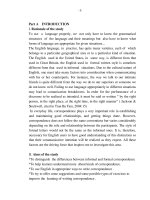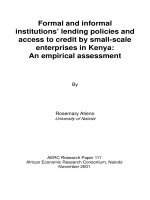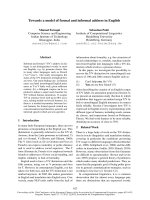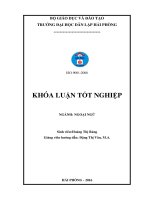group discussion business english formal and informal correspondence
Bạn đang xem bản rút gọn của tài liệu. Xem và tải ngay bản đầy đủ của tài liệu tại đây (997.5 KB, 20 trang )
<span class="text_page_counter">Trang 1</span><div class="page_container" data-page="1">
THUONG MAI UNIVERSITY ENGLISH FACULTY
---
GROUP DISCUSSION BUSINESS ENGLISH 1.1
</div><span class="text_page_counter">Trang 2</span><div class="page_container" data-page="2">THE REVIEW AND EVALUATION RECORD
GROUP MEMBER 7Comment: All members try to fully participate in the discussion, and be conscious and responsible for active teamwork.
(Leader)
- Part 1,2 I: Complete the task well.
20 Nguyễn H ng Mai ồ - Part IV Complete the task welland give positive
41 Lê Trần Qu nh Trang ỳ - Part II:2.1+2.2
Complete assigned taskwell and actively
contribute ideas
49 <sub>Đào Thị Khánh Vinh </sub> - Part 3 I:- Part 2: 1
Actively participate in discussions, and complete deadlines
quickly
</div><span class="text_page_counter">Trang 3</span><div class="page_container" data-page="3">DISCUSSION REPORT
GROUP 7MODULE: BUSINESS ENGLISH 1.1 Module code: ENPR4811_04
- MEETING MINUTES 1- Time: From 9 p.m. to 10 p.m., October 24 , 2023. <small>th</small>Place: Google Meet
Participants: Pham Thi Lan Anh Nguyen Hong Mai Nguyen Thi Minh Phuong, , , Nguyen Ngoc Quynh, Le Tran Quynh Trang, Dao Thi Khanh Vinh.
Contents for discussion:
– Taking roll calls and greetings.
– Agreeing, reviewing, and selecting content– Division of tasks
– Choosing a PowerPoint template
Conclusion: The next online meeting will occur on October 11 , 2023 after finishing <small>th</small>writing content tasks.
Meeting evaluation: All members participate in serious meetings and lively discussions. The meeting completed the set goals, solved content problems, selected templates,... In short, the meeting took place effectively.
Ha Noi, October 24 , 2023.<small>th</small> Leader Phạm Th Lan Anhị
</div><span class="text_page_counter">Trang 4</span><div class="page_container" data-page="4">- MEETING MINUTES 2 - Time: From 10 p.m to 11.00 p.m. on November 11 , 2023 <small>th</small>Place: Google Meet
Participants: Pham Thi Lan Anh, Nguyen Hong Mai, Nguyen Thi Minh Phuong, Nguyen Ngoc Quynh, Le Tran Quynh Trang, Dao Thi Khanh Vinh.
Contents for discussion:
– Making a few alterations to the contents. – Contributing ideas to create minigames. Conclusion:
– Edit the slide and finish. – Finish writing content task.
– Get more new ideas to develop the presentation.
Ha Noi, November 11 2023.<small>th,</small> Leader Phạm Th Lan Anh ị
</div><span class="text_page_counter">Trang 5</span><div class="page_container" data-page="5">THANK YOU
First of all, the representative of Group 7, I would like to express my sincere thanks to Mrs. Tran Thi Bich Lan who teaches Business English 1.1, we can complete the topic of discussion.
The discussion has been an effort for many weeks with all the passion and enthusiasm; however, due to limited knowledge and not having much practical experience, it is difficult to avoid shortcomings in the research process. We are very respectful of your suggestions for our discussion to be more complete.
Thank you very much!
Leader ạm Thị Lan AnhPh
</div><span class="text_page_counter">Trang 7</span><div class="page_container" data-page="7">I. Introduction
1. The current situation:
- As technology has been developing every day, messaging apps like Messenger, Zalo, etc… are most of our preferred modes of communication that enable us to communicate and exchange information quickly without taking as long to react as in traditional correspondence. However, letters still have a major use a nd importance in our society. - Letters have always been an effective mode of communication for everyone. Nowadays, people find it convenient to send letters through email instead of Traditional posts. Formal letters and Informal letters are often used to communicate or share ideas for various purposes.
2. Definition:- What is Correspondence?
Correspondence is communication by letters or email and also the letters or emails exchanged. A correspondence is a written form of communication between a sender and a recipient: letters, emails, or other messages, etc.
- Definition of a Formal Letter
Formal correspondence can also be referred to as “professional writing,” and called Business Letters, ranging from writing professional emails to writing proposals or creating web content. Essential for all early career researchers. Formal correspondence is letters that are written in a strict and specific format. Formal letters are naturally much more formal in style than informal/friendly letters.
- Definition of an Informal Letter
Informal letters are personal letters that are written to let your friends or family know about what is going on in your life and to convey your regards. An informal letter is usually written to a family member, a close acquaintance, or a friend. The language used in an informal letter is casual and personal.
3. Structure
3.1. Formal correspondence - Sender’s Name and Address
</div><span class="text_page_counter">Trang 8</span><div class="page_container" data-page="8"><small>• </small> I am writing to ask for information about small businesses.
<small>• </small> I am writing to inform you that we have not yet received payment for ... - Body Paragraphs: The second and following paragraphs should provide the main information of the letter and contain the relevant information behind the writing of the letter as well as build on the main purpose in the introductory first paragraph.
- Final Paragraph: The final paragraph should shortly summarize the intent of the formal letter and end with some call to action.
<small>• </small> If you have any questions, please let me know. / Feel free to contact me if you have any questions.
<small>• </small> I appreciate your cooperation. <small>• </small> Thank you in advance.
<small>• </small> I look forward to hearing from you. / I look forward to your reply. - Complimentary close
</div><span class="text_page_counter">Trang 9</span><div class="page_container" data-page="9">- Body of the letter (Actual message): Further details, Closing sentences.- Complimentary close.
• Best wishes • Best regards. • Sincerely - Name and Sign
II. Differentiate between formal and informal correspondence 1. Similarities
- Details of structure to make formal and informal correspondences clear and understandable:
Greeting <sub>• Dear + name </sub>• Hello/Hi
<small>• </small> Dear Sir/Madam <small>• </small> Dear Mr. Mrs./ +
Surname Opening
sentence
<small>• </small> I haven’t spoken to you in ages…
<small>• </small> Thanks for the letter/email…
<small>• </small> I hope this letter/email finds you well <small>• </small> Thank you for your
letter/email regarding… Starting the
letter & reason for writing
<small>• </small> How have you been? Let me tell you about …
<small>• </small> I’m writing this email/letter about…
<small>• </small> I am writing to complain/inform or to request information about… <small>• </small> I am writing to you
regarding…
</div><span class="text_page_counter">Trang 10</span><div class="page_container" data-page="10">Providing information
bring your passport to the interview…
<small>• </small> Please find attached my application form. Final
• The letter needs to be arranged logically which requires each idea and information must be associated with each other. When writing correspondences, writers should not continuously move from one topic to another without completely clarifying the information on each topic.
• Besides, it had better keep the information to the essentials and concentrate on organizing it in a clear and logical manner rather than expanding too much. • The tone of the letter needs to show consistency throughout the letter.
• It is believed that writers should use simple sentence structures to briefly express the content that needs to be discussed. Specifically, do not use too many passive sentence structures when not necessary in this type of letter.
• Using words that are not too formal and expressions that are not complicated and easy to understand.
</div><span class="text_page_counter">Trang 11</span><div class="page_container" data-page="11">• Furthermore, writers must avoid writing sentences that are difficult to understand or cause readers to misunderstand and remember to utilize sentences that have all sentence components and complete meaning.
- Politeness: Politeness is an important factor that needs to be paid attention to avoid giving readers a bad impression or feeling of being offended.
errors, errors in word form, errors in tense use, errors in use of prepositions, errors in punctuation, errors in missing conjunctions, etc.
2. Differences 2.1. Purpose
• Asking for updates of receivers.
- The author makes use of informal correspondence when inviting people for family gatherings, and meetings with soulmates.
</div><span class="text_page_counter">Trang 12</span><div class="page_container" data-page="12">- In an academic context, it combines personal essays and creative writing (fiction, and romantic novels... related to the writer’s interests).
- Formal correspondence: titles are used, e.g.: “Mr.”, “Mrs.”, “Dr.”. - Informal correspondence: titles may be omitted.
2.2.4. Content:
- Formal correspondence: Depending on the type of its letter:
• Letter of complaint: This is addressed to the seller and generally includes the details regarding the lack of quality, quantity, and the like.
• Letter of inquiry: is written for collecting information. It helps a person to have information on course or job, price of service or product, terms and orders of working agreement.
→ It is written for official reasons.
- Informal correspondence: the writer mentions personal anecdotes. 2.2.5. Closing of the letter:
- Formal correspondence: the closing is more common than the other (sincerely, respectfully…)
</div><span class="text_page_counter">Trang 13</span><div class="page_container" data-page="13">- Informal correspondence: the informal closing is used (best wishes, yours, love,…) 2.2.6. Signature:
- Formal correspondence: full name and signature.
- Informal correspondence: Often just the first name or a nickname. 2.3. Tone
2.3.1. Formal correspondence
The tone in a formal correspondence is called a professional tone. A professional tone ensures your correspondence sounds respectful, polished, and appropriate for a formal setting.
- It can come off as cold or personal, and being too casual, which can seem unprofessional.
- It involves using clear language, maintaining politeness, and refraining from using colloquial language, slang, or contractions.
There are a few key tips to keep in mind:
1. Use formal language: stick to proper grammar and avoid using contractions (e.g., ... use "do not" instead of " don't"). Also, avoid slang and colloquial phrases which may not be understood by everyone.
2. Be respectful and polite: Even if you are writing a complaint or a challenging message, make sure to express your thoughts in a respectful and polite manner. 3. Stay focused and clear: Keep your message concise and to the point. This shows
respect for the recipient's time and makes your correspondence more effective. 4. Avoid personal opinions: Unless it's necessary, avoid expressing personal opinions.
Stick to the facts and be objective. 2.3.2. Informal correspondence
On the other hand, an informal tone is more personal, and relaxed, and can be used when writing to friends, family, or close colleagues.
Features of an informal tone:
1. Using Contractions and abbreviations.
</div><span class="text_page_counter">Trang 14</span><div class="page_container" data-page="14">2. Using colloquial expressions or slang.3. Including personal stories and anecdotes.
Remember the tone of your correspondence plays a significant role in how your message is received, so choose wisely.
2.4. Language
3. Examples
Formal Letter Example
Chris McCarthy 32 Main Street St. Julian's, Malta STJ 3153
Correct grammar and vocabulary Lack of formal grammar and vocabular
</div><span class="text_page_counter">Trang 15</span><div class="page_container" data-page="15">Jane Smith Marks and Spencer 173 Oxford Street London, W1D 2JR United Kingdom August 16, 2016
Dear Ms. Smith,
This is where you will introduce yourself and explain why you are writing. Include examples or specifics to explain your point here. If you need a third paragraph to suggest how your goal should be accomplished or what the recipient needs to do to help you solve your issue, write it here.
Sincerely, Chris McCarthy
Informal Letter Example New Delhi
15th May 2021 Dear Father,
I have received such a nice gift from you on my birthday. My joy knew no bounds. This book gives me a lot of knowledge of vocabulary. Although a good number of my friends and relatives attended the birthday party, I missed you all the time. My friends and relatives gave me many things but your gift of a dictionary is unique in many aspects. This gift is a great source of joy for me. It will help me to cultivate the habit of reading good books. I shall preserve and treasure it throughout my life.
Yours lovingly,
</div><span class="text_page_counter">Trang 16</span><div class="page_container" data-page="16">III. How to write correspondence better 1. Know your audience
Before you start writing, you need to identify who your audience is and what their needs and expectations are. For example, if you are writing to a potential client, you may want to use a formal and persuasive tone, highlight your qualifications, and provide specific details. If you are writing to a colleague, you may use a more casual and friendly tone, and focus on the main points and action items.
2. Follow the standard structure
Most professional correspondence follows a standard structure that consists of three main parts: opening, body, and closing. Therefore, make sure your letter is well-organized and follows a logical and coherent structure. Use headings, bullet points, and other visual aids to help your reader quickly identify the most important information.
3. Use clear and concise language
One of the key elements of writing professional correspondence is to use clear and concise language that conveys your message effectively and accurately. You should avoid using slang or idioms and redundant words that may obscure or weaken your message. Instead, you should use simple, direct, and precise words that express your ideas clearly. You should also use short and simple sentences and paragraphs that are easy to read and understand.
4. Proofread and edit your correspondence
Before you send or submit your professional correspondence, you should always proofread and edit it carefully to ensure that it is free of errors, inconsistencies, or inaccuracies. You can use tools such as spell checkers, grammar checkers, or online editors to help you with this process.
</div><span class="text_page_counter">Trang 17</span><div class="page_container" data-page="17">IV. Conclusion
Basic for
Meaning A letter, written in formallanguage, in the stipulateformat, for official purposes.
A letter written in a friendlymanner, to someone you afamiliar with.
Tone Polite and professional Casual and friendly
Structure Clearly defined structure with headings
Relaxed structure, no specifiheadings
Contractions and Abbreviations
First name or nickname
Examples Business communication, joapplications, official requestscomplaints, inquiries, or ansituation that requires professional approach.
Catching up with a friendexpressing gratitude, sharinnews, or inviting someone tan informal gathering.
</div><span class="text_page_counter">Trang 18</span><div class="page_container" data-page="18">1. Things to Avoid When Writing a Formal Letter
1. Going off on tangents, or including information that is unrelated to the topic at hand 2. Personal information or anecdotes, unless it is pertinent to the situation at hand 3. Using vulgar, disrespectful, or otherwise inappropriate language
4. Using slang or colloquial terms
5. Using contractions, such as “can’t” or “won’t “; instead, use the uncontracted “cannot” and “will not ”
6. Using the abbreviated forms of words, such as “TV” for “television” and “photo” for “photograph “
2. Tips and Tricks for Formal Letter Writing
When writing the body of a formal letter, keep the following tips in mind so as to write clearly and concisely.
1. In the first paragraph, include the 5 W’s and 1 H that prompted the letter in the first place: who, what, when, where, why, and how
2. Keep all information firmly on topic and related to the matter at hand
3. Make sure to include any relevant reference information that the reader may immediately need, such as account numbers or other referential information 4. Keep paragraphs short, preferably no longer than 3-5 sentences
5. Be respectful; use please and thank you
6. Make sure to proofread the letter before printing or sending so as to check for it grammatical and spelling errors
7. Learn more about how to write a perfect letter in English.
Differences between Formal and Informal Letters lie not just in the language and structure, but also in the intended purpose and the depth of personal connection. While formal letters maintain professionalism and structured communication, informal letters offer a more relaxed and friendly approach. Understanding these distinctions equips us to effectively navigate diverse communication scenarios in both professional and personal realms.
</div>








